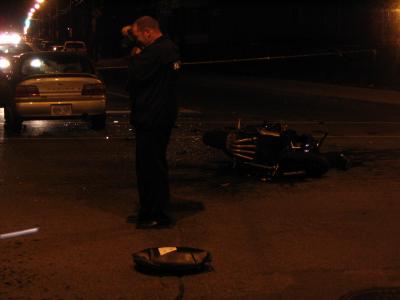Introduction
Based on what I understand, CiscoPro was Cisco’s attempt at selling routers with crippled OS loads with discounts through resellers. It was the case in the late 90s, and certain models of routers (100x, 25xx, 45xx, 16xx) were available in the olive green of Cisco, and in white. White boxen were the CiscoPro variety, and would only run so called “CiscoPro” featuresets only. By IOS release 11.2 Cisco abandoned that practice, and offered a way to convert all existing CiscoPro routers into routers that would accept standard Cisco IOS load.
Hardware-wise both CiscoPro white boxes and reguar Cisco boxes in olive green are identical, and the only difference is in the non-volatile memory.
As most CiscoPro units still in the field have been converted, I’ll try to document what needs to be done to a CiscoPro router to make it happier, and potentially useful. As it happened, I got my hands on two Cisco routers with white paintjob – CPA2503 (sh ver below) and CPA2520, which correspond to Cisco 2503 and 2520.
Basic Idea
Expect CiscoPro router to have much less flash and RAM then Cisco lists as standard for the model in question. If this is a router you will use for CCNA tests, do shell out some money for flash and RAM upgrades, as they will be necessary to run versions of IOS that you can test on.
Grab the aproprite upgrade file from ftp://ftp-sj.cisco.com/pub/access/ and a copy of the upgrade image. For CiscoPro CPA25xx routers you need cpa25-up.bin.
Configure the route so it can talk to your tfpt server (DO password recovery if needed, it’s on Cisco web site), back up existing IOS, copy the cpa-25-up.bin into the flash of the router, and get it to reboot with that image. cpa25-up.bin will modify the non-volatile memory to remove the CiscoPro only requirement, and which point you can boot from the ROM, and flash in a modern IOS (or at least IOS that you backed up initially).
Step by Step procedure for Windows users
If you boot up a Cisco, and at “sh ver” it shows the following:
SDN-Link>sh ver Cisco Internetwork Operating System Software IOS (tm) 3000 Software (CPA25-Y-L), Version 11.1(24), RELEASE SOFTWARE (fc1) Copyright (c) 1986-1999 by cisco Systems, Inc. Compiled Mon 04-Jan-99 20:00 by richv Image text-base: 0x030206C0, data-base: 0x00001000 ROM: System Bootstrap, Version 5.2(8a), RELEASE SOFTWARE ROM: 3000 Bootstrap Software (IGS-RXBOOT), Version 10.2(8a), RELEASE SOFTWARE (fc1) ISDN-Link uptime is 2 minutes System restarted by power-on System image file is "flash:cpa25-y-l.111-24.bin", booted via flash cisco CPA2500 (68030) processor (revision F) with 2048K/2048K bytes of memory. Processor board ID 04595024, with hardware revision 00000000 Bridging software. X.25 software, Version 2.0, NET2, BFE and GOSIP compliant. Basic Rate ISDN software, Version 1.0. Authorized for CiscoPro software set only. 1 Ethernet/IEEE 802.3 interface. 2 Serial network interfaces. 1 ISDN Basic Rate interface. 32K bytes of non-volatile configuration memory. 4096K bytes of processor board System flash (Read ONLY) Configuration register is 0x2102 ISDN-Link>
You have on your hands an affected router that needs some tender loving care.
For starters, expect that CiscoPro router will have minimum DRAM and flash. Cisco states that they shipped 2500s with 8 megs of DRAM and Flash. As you can see, this 2503 has only 4 megs of each. DRAM for 2500 is simple – it’s standard 72pin PC RAM, so if you have a 16 meg, single sided, it will work. Flash is much harder to obtain, and folks like MemoryX want ~80 USD for a 16 meg kit.
2500 platform is limited to 16 megs of flash and 16 megs of DRAM, but that would allow you to run IOS 12.3.16, which is the latest at the time of this writing. In other words, with over a million 2500s in the field, they will be supported for a while longer.
Next, you need to get yourself a PC with Windows. I did my upgrade under Windows 2000, although you might get away with a Unix/MacOS X box with tip, minicom, ZTerm.app, etc.
Under Windows you need to get yourself a copy of Cisco RSL (Router Software Loader) from ftp://ftp-sj.cisco.com/pub/access/ and a copy of the upgrade image. From the Cisco FTP site I grabbed cpa25-up.bin and RSL 7.11.
Then I configured the console cables so I could talk to the router over hyperterminal. In process I needed to do password recovery (drop to bootrom, set the confreg to 0x2142, reboot, say no at the original config) on one of the routers. I’ve used Cisco TFTP server for windows that ships with RSL (look for installer in the RSL711 directory) to back up the cpa25-xxxx.bin IOS loads, as they are hard to find and fit in 4 megs of flash requirement that I currently have. I also had to look around, and find an even older firmware image for 2500 that would fit into flash. At http://www.tfr.org/cisco-ios/ I grabbed router-2500-serial.bin which is IOS ™ 3000 Software (IGS-I-L), Version 10.3(5), RELEASE SOFTWARE (fc1). Of course 2500 and 3000 are basically the same router, so it was a fair deal.
I created a directory “images” in RSL711 directory, and dropped cpa25-y-l.111-24.bin that I recovered from the router, router-2500-serial.bin that I grabbed from above site, and cpa25-up.bin
Then I disconnected HyperTerminal, and started RSL. RSL found my 2503, queried it, and asked me what IOS image I’d like to run on it. I pointed at the IOS 10.3, at which point RSL told me that I need to rename cpa25-up to a different name, as it can’t find it. I renamed cpa25-up.bin to what it asked me, and told RSL to continue. It went on for a while occasionaly looking , and about 5 minutes later it told me that it is done.
NOTE: Tell RSL to NOT back up any files. That’s why you backed up IOS as the first step. If you do tell it to back up, it will not finish running and just sit there, because it is expecting somewhat different prompts then what IOS on my routers was offering it.
I shut RSL down, and connected to the router over hyperterminal. It was happily running IOS 10.3(5). At that point I’ve started Cisco TFTP server again, and flashed in original IOS (You can use RSL for that too, it will work. Again, no backups, as you already did them).
So after a RAM upgrade, and this convoluted procedure I were left with:
Router#sh ver Cisco Internetwork Operating System Software IOS (tm) 3000 Software (CPA25-Y-L), Version 11.1(24), RELEASE SOFTWARE (fc1) Copyright (c) 1986-1999 by cisco Systems, Inc. Compiled Mon 04-Jan-99 20:00 by richv Image text-base: 0x030206C0, data-base: 0x00001000 ROM: System Bootstrap, Version 5.2(8a), RELEASE SOFTWARE ROM: 3000 Bootstrap Software (IGS-RXBOOT), Version 10.2(8a), RELEASE SOFTWARE (fc1) Router uptime is 0 minutes System restarted by power-on System image file is "flash:cpa25-y-l.111-24.bin", booted via flash cisco 2500 (68030) processor (revision F) with 16384K/2048K bytes of memory. Processor board ID 04595024, with hardware revision 00000000 Bridging software. X.25 software, Version 2.0, NET2, BFE and GOSIP compliant. Basic Rate ISDN software, Version 1.0. 1 Ethernet/IEEE 802.3 interface. 2 Serial network interfaces. 1 ISDN Basic Rate interface. 32K bytes of non-volatile configuration memory. 4096K bytes of processor board System flash (Read ONLY) Configuration register is 0x2102 Router#
And everything was well in the world…



